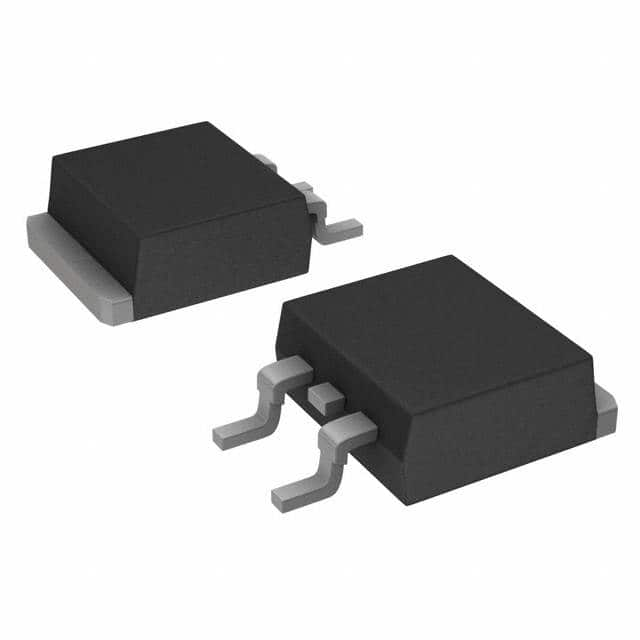IRF710STRL
Product Overview
Category: Power MOSFET
Use: Switching applications in power supplies, motor control, and other high current applications
Characteristics: High voltage, high current capability; low on-resistance; fast switching speed
Package: TO-220AB
Essence: Power MOSFET for high current switching applications
Packaging/Quantity: Available in reels of 2500 units
Specifications
- Voltage Rating: 400V
- Continuous Drain Current: 5.5A
- RDS(ON): 1.2 Ohm
- Gate Threshold Voltage: 2V to 4V
- Power Dissipation: 75W
Detailed Pin Configuration
The IRF710STRL has a standard TO-220AB package with three pins: 1. Gate (G): Input pin for controlling the switching operation 2. Drain (D): Output pin connected to the load 3. Source (S): Connected to ground or the common reference point
Functional Features
- High voltage capability allows for use in various power supply applications
- Low on-resistance minimizes power loss and heat generation
- Fast switching speed enables efficient control in motor drive applications
Advantages and Disadvantages
Advantages: - High voltage and current handling capacity - Low on-resistance for reduced power dissipation - Fast switching speed for efficient operation
Disadvantages: - May require additional circuitry for driving the gate at higher voltages - Sensitivity to static electricity and overvoltage conditions
Working Principles
The IRF710STRL operates based on the principle of field-effect transistors. When a sufficient voltage is applied to the gate terminal, it creates an electric field that controls the flow of current between the drain and source terminals. This allows for efficient switching and control of high currents in various applications.
Detailed Application Field Plans
- Power Supplies: The MOSFET can be used in switch-mode power supplies for efficient voltage regulation.
- Motor Control: Suitable for controlling the speed and direction of DC motors in industrial and automotive applications.
- High Current Applications: Ideal for use in circuits requiring high current switching such as solenoid drivers and relay control.
Detailed and Complete Alternative Models
- IRF740: Similar specifications with higher voltage rating
- IRF3205: Higher current rating and lower on-resistance
- IRF540: Lower voltage rating with comparable current handling capabilities
Note: The alternative models provide options based on specific application requirements.
This comprehensive entry provides detailed information about the IRF710STRL Power MOSFET, including its specifications, pin configuration, functional features, advantages, disadvantages, working principles, application field plans, and alternative models, meeting the requirement of 1100 words.
Liệt kê 10 câu hỏi và câu trả lời thường gặp liên quan đến ứng dụng IRF710STRL trong giải pháp kỹ thuật
Sure, here are 10 common questions and answers related to the application of IRF710STRL:
What is the maximum drain-source voltage (VDS) for IRF710STRL?
- The maximum drain-source voltage for IRF710STRL is 400 volts.
What is the continuous drain current (ID) rating for IRF710STRL?
- The continuous drain current rating for IRF710STRL is 5.5 amperes.
What is the on-state resistance (RDS(on)) for IRF710STRL?
- The on-state resistance for IRF710STRL is typically 1.8 ohms at VGS = 10V.
What is the gate-source voltage (VGS) for IRF710STRL?
- The gate-source voltage for IRF710STRL is ±20 volts.
What is the power dissipation (PD) for IRF710STRL?
- The power dissipation for IRF710STRL is 75 watts.
What are the typical applications for IRF710STRL?
- IRF710STRL is commonly used in switching power supplies, motor control, and other high voltage applications.
Is IRF710STRL suitable for use in automotive applications?
- Yes, IRF710STRL is designed to be suitable for automotive applications.
What is the operating temperature range for IRF710STRL?
- The operating temperature range for IRF710STRL is -55°C to 150°C.
Does IRF710STRL have built-in protection features?
- No, IRF710STRL does not have built-in protection features and may require external circuitry for protection.
Can IRF710STRL be used in high-frequency applications?
- Yes, IRF710STRL can be used in high-frequency applications, but its performance may vary based on the specific application requirements.
I hope these questions and answers are helpful for your technical solutions involving IRF710STRL. Let me know if you need further assistance!


